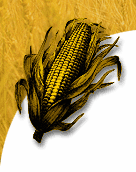By Kamyar Enshayan
Prairie Writers Circle
(Saturday, March 1, 2003 -- CropChoice guest commentary) -- I was born in northern Iran , right on the "axis of evil," and I want to tell you about a kind of true homeland security.
There is much talk about bio-terrorism and how to safeguard our system of food and agriculture from terrorists. But the forces systematically destroying American agriculture are almost entirely domestic: nitrogen pollution of our streams, atrazine in our drinking water, farm policies that kill independent businesses and small towns, genetic manipulation for profits and power, and monopolization of agricultural markets by a few huge corporations.
One clear and troubling example of a domestic biological threat to our system of food and agriculture is the way the industrial meat giants raise and process livestock. Last year, snipers killed 12 people around the nationís capital. Listeria bacteria suspected of coming from poultry processors killed eight people, sickened at least 54 others and caused three miscarriages or stillbirths in the Northeast, prompting a record recall of 32 million pounds of meat. I asked my students what differences there were between the two tragedies.
The class had just read Eric Schlosserís "Fast Food Nation," which documents how lax some of the nation's meat-packing giants, and even the government, have been about food safety. The result: contamination that has led to injury and death. The only differences my class saw were that the shootings received massive news coverage but the poisoning victims in the listeria case died quietly in hospitals with little media attention.
There are other ways of protecting our food and agriculture. My friend Mary Berry Smith, who farms in Kentucky , says, "Our country, through its ruinous desire for cheap food, has nearly destroyed the safest food system we could have: farmers feeding the people closest to them." Her family sells most of their farm products direct to customers: "Our customers trust us to provide delicious, healthy, safe food; we trust them to pay us a fair price."
The people of Black Hawk County, Iowa , annually spend nearly $240 million on groceries and another $130 million on eating out. Under our industrialized system, most of these food dollars leave our county and state.
Six years ago, with help from the Leopold Center for Sustainable Agriculture and the USDAís Sustainable Agriculture Research and Education program, I approached the dining services directors of our university, our local hospital and the owner of a locally owned restaurant about buying a greater portion of their food from nearby farms. The aim was to keep a significant part of these dollars in our community and region, as well as to build local relationships. "Value-subtracting" industrial agriculture and the resulting "value-missing" markets create insecurities for the very people who grow our food.
Ten businesses and institutions we have worked with over five years have spent nearly $750,000 of their food purchases locally. At Rudyís Tacos, one of our partners in Waterloo , 71 percent of the restaurantís food budget, $143,000, goes for fresh, locally grown ingredients. For most restaurants, that percentage would be in single digits, if any. Bartels Lutheran Home in Waverly, another partner, buys two to three cattle each month, raised locally and processed at a local meat locker. Last year Bartels bought $40,000 worth of locally raised beef and vegetables. Three years ago the beef came from an unknown source, and the $40,000 left the region. The University of Northern Iowa , where I work, recently bought its first local cow!
This is "value-retained" agriculture, and we need more of it. If our county set a goal of retaining just 10 percent of our food dollars, that would amount to $37 million every year . And that would be real community economic development based on our best assets: our people and our land.
These food buyers have come to understand that their decisions crucially affect the vitality of nearby farms and businesses. They have decided to buy their meats from farmers they know for this reason, and because they can find out what the animals were fed and how they were raised. Through local, inspected lockers, they are assured that their ground beef came from that cow, and not from a mixture of thousands of other cattle from an unknown place.
This work has expanded the web of local relationships, which is the essence of local economy and local life. This is the kind of homeland security I think about.
Kamyar Enshayan wrote this piece for the Prairie Writers Circle, a project of The Land Institute, which is working to develop perennial grain agriculture in Salina, Kan. Enshayan works at the Center for Energy and Environmental Education at the University of Northern Iowa, in Cedar Falls, where he is an adjunct professor.



